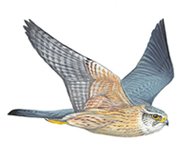
151.Merlin
I was on duty at the Rspb Hide on Belfast Harbour today. Not long after I opened up the two Ian's and Philip West arrived. They are known as "The Leica Boys"" or so I am told. Philip very quickly spotted a Curlew Sandpiper on the far shore and soon after I noticed a wader in front of the roadside hide which I couldnt identify from the way it was positioned. Fortunately three much more experienced eyes confirmed it was another Curlew Sandpiper and then another just behind it.
 They then disappeared down to the roadside hide. I had quite a few visitors at the time and was pointing the birds out when I realised there were four of them and one on the far shore so five Curlew Sandpiper in all.
They then disappeared down to the roadside hide. I had quite a few visitors at the time and was pointing the birds out when I realised there were four of them and one on the far shore so five Curlew Sandpiper in all.Phil came back and suggested I try and get some photos and as there was another volunteer visiting he held the fort while I went and got a few shots of them. My unrepaired camera has a exposure problem and it massively overexposes so was experimenting with it to see if I could get a half way decent image.
Otherwise the afternoon was pretty uneventful not even a visit from the peregrine that is terrorising the site at the moment.
On my way home I decided to have a quick look at the Quoile Pondage. I was driving down to the hide on a single track road when I had to pull in to let a car get past. At that moment an adult male merlin suddenly popped over the hedge and was flying low alongside the car coming towards me. I thought it was going to go under my car when it just appeared in front of me flying up over the car. I couldnt have been more than two feet from it. It made my day as it was my next tick for my list.
The Merlin (Falco columbarius) is a falcon that breeds in northern North America, Europe and Asia.
In North America it was once known as the pigeon hawk, and its scientific name (from Latin columba, a dove) also refers to this popular prey item. However, the Merlin is a falcon, not a hawk, so the old American name is to be avoided.
This small bird of prey breeds in open country such as moorland, taiga or willow or birch scrub. Like the larger Peregrine Falcon, it is migratory, wintering in more temperate regions. Northern European birds move to southern Europe and North Africa, and North American populations to the southern USA and northern South America. In winter, the Merlin may be found in almost any open country, from coasts to prairies to desert scrub. In the mildest parts of its breeding range, such as Great Britain, it will desert higher ground and move to coasts and lowland.

In Europe, Merlins will roost communally in winter, often with Hen Harriers. In North America, communal roosting is rare, and Merlins are well known for attacking any birds of prey that they encounter, even eagles.
The male Merlin has a blue-grey back and orange-tinted underparts. The female and immature are dark brown above and whitish spotted with brown below. American subspecies range from pale (Great Plains) to nearly black (Pacific Northwest). This species' small size, darker underparts, and less strongly marked face distinguish it from the Peregrine Falcon.
Merlins rely on speed and agility to hunt their prey, which is mainly small birds such as larks and pipits and also large insects. They often hunt by flying fast and low, typically less than 1 metre above the ground, trying to take prey by surprise.
Merlins nest on the ground in most of their range. In the UK this is usually in a shallow scrape on heather moorland. They have a preference for long heather so are suseptible to over management, by burning.
In medieval Europe, Merlins were popular in falconry.
1 comment:
Interesting to see a merlin at somewhere I go every week, we've seen a few small falcon-like birds out over the hide area, towards the fields on the left, but to be honest would always have assumed they were kestrels. Might have to look twice next time, well, before winter's back completely :)
Post a Comment